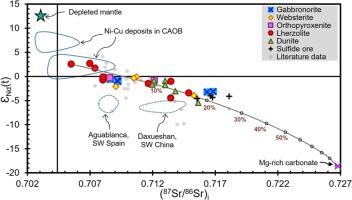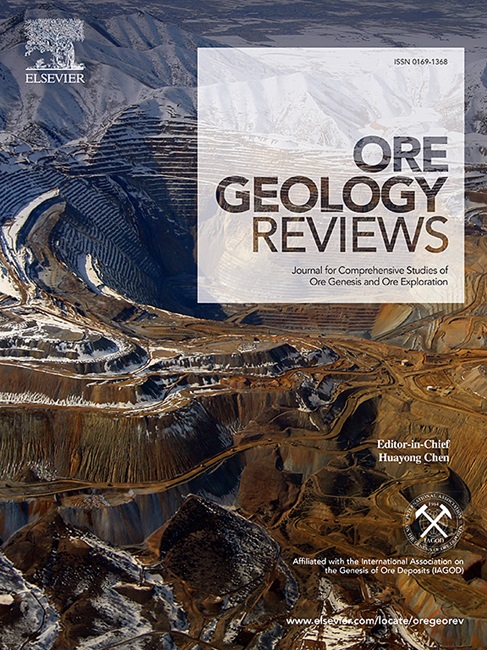Geochemical and Sr-Nd isotopic implications for the petrogenesis of the late Silurian Shitoukengde mafic–ultramafic intrusion in the East Kunlun Orogen, NW China
IF 3.2
2区 地球科学
Q1 GEOLOGY
引用次数: 0
Abstract
The Shitoukengde mafic–ultramafic intrusion is the host of the second-largest sulfide deposit after the Xiarihamu Ni-Co deposit in the East Kunlun Orogenic Belt (EKOB), northern Tibet Plateau, China. Despite several studies, the age, petrogenesis, and the cause of low Ni-tenor for this intrusion remain poorly constrained. In this study, zircons separated from the pyroxenite at Shitoukengde yield a SHRIMP U-Pb age of 418.9 ± 3.1 Ma, corresponding to the widespread magmatism of the late Silurian to early Devonian in the EKOB. Whole-rock major and trace element compositions indicate that fractional crystallization played a key role in controlling the magma composition and element distribution within the intrusion. Mafic-ultramafic rocks of the intrusion, particularly peridotite, have highly variable and exceptionally elevated (87Sr/86Sr)i and negative ɛNd(t) values. Some samples from the Shitoukengde intrusion exhibit initial Sr-Nd isotope ratios that overlap with those from the Xiarihamu intrusion, while others (e.g., peridotite) display higher (87Sr/86Sr)i values than those observed in the latter. The unusual Sr-Nd isotopic compositions of the Shitoukengde intrusion could be attributed to the assimilation of Mg-rich carbonate within a deep-seated magma chamber. This contamination process facilitates the crystallization of olivine, consequently reducing Ni content in residual magma. Furthermore, the contamination of Mg-rich carbonate may promote oxygen fugacity and thus enhance the solubility of sulfur while restricting the sulfide saturation in the magma. We thus propose that the extensive contamination of Mg-rich carbonate is a key factor contributing to the relatively low Ni-tenor observed at Shitoukengde.

地球化学和Sr-Nd同位素对中国西北部东昆仑造山晚志留世石头坑德黑云母-超黑云母侵入体成岩作用的影响
狮头坑德岩浆-超基性侵入体是中国西藏高原北部东昆仑造山带(EKOB)中仅次于夏日哈木镍钴矿床的第二大硫化物矿床。尽管进行了多项研究,但对该侵入体的年龄、岩石成因和低镍态的成因仍缺乏充分的了解。在这项研究中,从狮头坑德辉绿岩中分离出的锆石得出的 SHRIMP U-Pb 年龄为 418.9 ± 3.1 Ma,与 EKOB 晚志留纪至泥盆纪早期的广泛岩浆活动相对应。全岩主要元素和痕量元素组成表明,分块结晶在控制侵入体内岩浆组成和元素分布方面发挥了关键作用。侵入体中的黑云母-超黑云母岩石,尤其是橄榄岩,具有变化很大且特别高的 (87Sr/86Sr)i 值和负ɛNd(t) 值。一些来自狮头坑德侵入体的样本显示出与夏里哈木侵入体重叠的初始 Sr-Nd 同位素比值,而另一些样本(如橄榄岩)则显示出比后者更高的 (87Sr/86Sr)i 值。狮头坑德侵入体不寻常的Sr-Nd同位素组成可能归因于深埋岩浆腔内富含镁的碳酸盐的同化。这种污染过程促进了橄榄石的结晶,从而降低了残余岩浆中的镍含量。此外,富镁质碳酸盐的污染可能会促进氧的富集,从而提高硫的溶解度,同时限制岩浆中硫化物的饱和度。因此,我们认为富镁碳酸盐的广泛污染是导致在狮头坑德观测到的镍痕量相对较低的一个关键因素。
本文章由计算机程序翻译,如有差异,请以英文原文为准。
求助全文
约1分钟内获得全文
求助全文
来源期刊

Ore Geology Reviews
地学-地质学
CiteScore
6.50
自引率
27.30%
发文量
546
审稿时长
22.9 weeks
期刊介绍:
Ore Geology Reviews aims to familiarize all earth scientists with recent advances in a number of interconnected disciplines related to the study of, and search for, ore deposits. The reviews range from brief to longer contributions, but the journal preferentially publishes manuscripts that fill the niche between the commonly shorter journal articles and the comprehensive book coverages, and thus has a special appeal to many authors and readers.
 求助内容:
求助内容: 应助结果提醒方式:
应助结果提醒方式:


